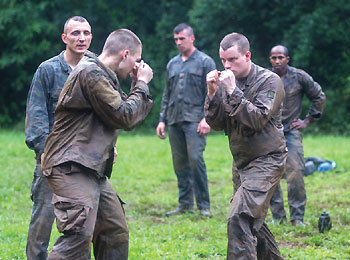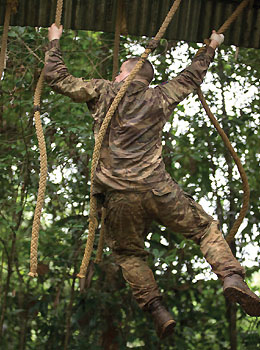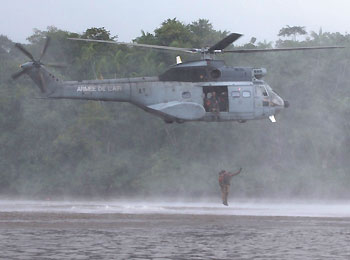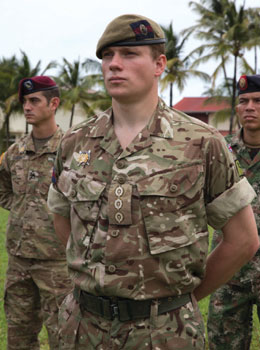|
COLDSTREAMER À LA LEGION
by Captain D J F Cuccio
Coldstream Guards
|
Monday, 25th January 2016, 2200hrs. I found myself stood to attention outside the guardroom of the rather aptly-named ‘Quartier Forget’ in Kourou, French Guiana. In the ranks stood men in berets of every shape and colour, including, of course, the famous white Képis of the Legionnaires. Even in the late evening the temperature was just under 30°C and the humidity was stifling. The words ‘LEGIO PATRIA NOSTRA’ (‘The Legion is our Fatherland’) were emblazoned in enormous gold letters across the imposing iron gates of the camp. Set just 5km ashore from Devil’s Island, the infamous former penal colony and setting for Henri Charrière’s 1969 novel ‘Papillon’, Quartier Forget is home to the ‘3eme Régiment étranger d’infanterie’ (3e REI), part of the French Foreign Legion.
 Corps à Corps -
Hand-to-hand combat lessons were
Corps à Corps -
Hand-to-hand combat lessons were
conducted almost daily |
 Corps à Corps - Gum shields in, sparring with a fellow
Corps à Corps - Gum shields in, sparring with a fellow
Stageur from the US Airborne as the cadre look on |
3e REI’s role in French Guiana is three-fold. Firstly, they protect the Centre Spatial Guyanais from where the European Space Agency launches its missions. We were fortunate to witness an Ariane 5 rocket launch on 27th January and it was truly remarkable. Imagine a deafening 746-tonne Schermuly being fired and you’ll understand. Secondly, 3e REI patrol French Guiana’s largely uninhabited 80,630km² of tropical rainforest in search of illegal gold-mining operations and smugglers which cost the French economy heavily. Thirdly, and unfortunately for me, 3e REI are responsible for running the ‘Centre d’entraînement à la forêt équatoriale’ or ‘Equatorial Rainforest Training Centre’ (CEFE) which was established by the French Army in 1987 to conduct survival, jungle warfare, and command courses. CEFE itself is situated deep in the rainforest, 160km south of Kourou.
Each year, CEFE host and run ‘Stage Jaguar International’, the longest and most arduous of their courses, an 8-week jungle warfare and command course to prepare officers and senior non-commissioned officers to lead a platoon (a ‘section’ in the French Army) on operations in the jungle. We humble ‘Stageurs’ were an entertaining mixture of nationalities; British, American, Canadian, German, Swiss, Brazilian, Colombian, Guatemalan, Mexican, Surinamese, Guyanese and, of course French, and a handful of Legionnaires. Many spoke neither French nor English, so the weeks that followed were to prove challenging.
 Tarzan - the author negotiates an aerial obstacle on
one of the assault courses
Tarzan - the author negotiates an aerial obstacle on
one of the assault courses |
|
 Aguerrissement - in the Legion, a day without assault courses is like a day without sunshine
Aguerrissement - in the Legion, a day without assault courses is like a day without sunshine |
The first week was held in Quartier Forget and consisted of acclimatisation via ‘aguerrissement’, a difficult word to translate into English, but its general gist is ‘hardening’ or ‘preparing for war’; ‘Beasting’ is probably our closest equivalent. Each day began shortly before 0500hrs and consisted of various physical activities such as running, swimming, circuits and assault courses, and we were kept busy until late at night. The events in isolation would not have been too difficult, but were made so by the relentless tempo and oppressive climate. The physical events were interspersed with weapon handling, communications and, crucially, language lessons. After our mandatory grade one haircuts, our names and respective ranks were replaced with numbers and we were squadded to-and-fro by our surly ‘Caporals’ and ‘Caporal-Chefs’. Worse still, we were forced to learn French drill, marching about with our hands outstretched like toy-soldiers in a Hamley’s window display. The group began to diminish in size almost immediately.
Soon those who remained found themselves sweating profusely on a coach, complete with the proverbially broken air-conditioning, heading south on our way to CEFE. The coach stopped 3km short of (and downhill from) the camp and, peeling ourselves off the faded seats, we were told to don our bergens, pick up our FAMAS rifles and run the last leg of the journey up a dirty sandstone track. But the fun didn’t stop here as we reached the top where more ‘aguerrissement’ ensued seemingly to the glee of the cadre. If we were lucky enough to be allowed anywhere near the hallowed inner sanctum of the cookhouse, 10 perfect chin-ups were mandatory if we wanted food. Thankfully, for most of the next seven weeks we were largely restricted to out-of-date tinned rations which in no way lived up to my gastronomic expectations of our Gallic neighbours. Poorly fed either way, we were swiftly moved deeper into the jungle by a ‘pirogue’, a motorised canoe which was the favoured means of transport.
The Stage was divided into various phases; the initial beat-up, tactics, techniques and procedures, survival and live firing, culminating with a fully tactical phase at the end, all carefully interspersed with generous helpings of ‘aguerrissement’ throughout. All of our instructors had an excellent grasp of their subject matter, be it river-crossing, putting an unsuspecting enemy in a choke-hold, making traps, or conducting patrols. Where the instruction slipped, it was invariably due to a loss in translation rather than a lack of actual know-how on the Legion’s part. The lessons were mostly excellent, but in hindsight, the Legion may not have been the best place to improve my French. There was a bizarre melange of languages here and we Stageurs were just as likely to be taught or indeed screamed at in Russian as we were in French, and shouts of ‘Davai, davai’ were as commonplace as ‘Allez, allez’.
 Raft-building - the author and a German Fallschirmjäger Sergeant use vines as lashings for a raft. It will be used to negotiate 5 miles of fast-flowing river the next day
Raft-building - the author and a German Fallschirmjäger Sergeant use vines as lashings for a raft. It will be used to negotiate 5 miles of fast-flowing river the next day |
The emphasis on upper-body fitness and hand-to-hand combat was markedly different to our own and it was not easy to adjust to. Every day, we climbed ropes without using legs and did hand-to-hand combat. There was an emphasis on assault courses or ‘pistes’ every other day and all of our trials were meticulously recorded by the cadre. There were four pistes in total, one set in a low swamp giving it various levels of difficulty depending on the state of the tide, an exclusively aerial piste suspended in the tree canopy like a scene from a Tarzan film, a collective piste conducted in sections with high walls and various command tasks, and lastly a horrendous stretcher-race piste consisting entirely of waist-deep mud, referred to as the ‘Piste Brancardage’, famous throughout the French Army. Though only 400 metres long, it takes a very good section around 40 minutes to complete as the hand-carved wooden casualty is so heavy and the mud so thick. It was one of the hardest physical undertakings I have ever done and whenever we met Legionnaires or other French soldiers, their first question would invariably be, ‘how quickly did you do the Piste Brancardage?’ I was glad to report that ‘3eme Groupe’ had completed it in 41 minutes, 10 minutes faster than the following section.
The pinnacles of the hand-to-hand combat lessons were a series of nerve-racking bouts with the instructors (where I learned how to fall on my backside repeatedly), and one particular night when we stood around a circle of burning barrels as pairs of numbers were called out to enter the ring and batter each other for two minutes until the whistle was blown. Of course, the Legion decided to make it fair by calling me out to spar twice with two French Commandos, both significantly taller and broader than myself. Although paired off evenly, as the two only had the slight weight advantage of a few stone, I soon had a bloody nose. The drawn-out minutes were made even longer as the other Stageurs were instructed to remain absolutely silent, making it both a painful and eerie experience. If you’re going to have your nose broken, it would have been nice to at least have had some cheering in the background, but this was all part of the psychology of ‘aguerrissement à la Legion’.
This Stage was well resourced and both the Legionnaires and French Stageurs observed that it was only because ‘you Americans and British’ were involved that we had so much ammunition, so many kilograms of explosives and so many flying hours. They certainly did not spare on aviation, and we were tested on the use of explosives and machetes to establish helicopter landing sites deep in the jungle. I could feel my inner ‘eco-friendly’ self reminding me that an area of rainforest the size of Wales was destroyed every day, but after a few weeks of being soaked through, covered in cuts, bites and assorted rashes, I found myself no longer caring as I merrily wrapped detonation cord around tree trunks. No sooner would we clear an HLS than a Puma from ‘L’Armee de l’Air’ would carefully negotiate its way down through the canopy to take us to our next objective. One of the more amusing activities was ‘heli-casting’: leaping out of a moving helicopter into water. We did this on a number of occasions and it was tremendous fun if not, perhaps, the most practical method of insertion.
Communications were difficult in the damp and dense jungle conditions. It was fascinating to see that the Foreign Legion still use Morse Code (which we were tested on thoroughly) via HF radio. It seemed strangely antiquated at first but was remarkably effective and offered us significant reachback even if establishing voice communications wasn’t possible. As a former RSO, I think Morse remains a skill we should try to keep up our sleeves.
 Heli-casting - the author plunges into an Amazonian river as part of a mission insertion
Heli-casting - the author plunges into an Amazonian river as part of a mission insertion |
The survival phase lasted for five days and began directly after a gruelling five days of ‘aguerrissement’, just to ensure that we were already well on our chin-straps. After a gruelling hour negotiating the ‘Piste Brancardage’ followed by a 15km march deeper into the trees, we were separated from our kit less a few crucial items (machete, water bottle, survival tin) and told simply to ‘survivez’. Bear Grylls makes it look far too easy. While our stomachs could still remember their last ration, we immediately built shelters, started fires and set about foraging for food. The shelters had to be elevated well above the jungle floor to deter the numerous ants, spiders, snakes and scorpions, so building them was an enormous effort and a huge expense of valuable calories.
To replace these calories, an American staff sergeant from the 75th Ranger Regiment and I were designated as the fishermen for the group and we caught an assortment of familiar and less-familiar species for the campfire. A particular highlight was when SSgt Sugimoto managed to catch an electric eel with our makeshift fishing rod. Unfortunately, we had used metallic fishing line and so he promptly found himself full of some unwanted voltage. Clutching the line in his spasming arms, it wasn’t until I heroically impaled the writhing creature with my spear that he could let release his vice-like grip from the 4000 volts! Ray Mears would have been proud. The eel wasn’t the best meal we’d ever eaten but the gelatinous chunks roasted over the fire were worth it nonetheless. Actually, Cayman meat soon became a firm favourite in the Section alongside a larva that gestates inside the nut of a plant called the ‘mourou mourou’. As the grubs spend their early life eating the coco-like flesh of the fruit they taste just like wriggly coconut milk.
By the fifth day of eating grubs, morsels of fish and the odd chunk of coconut, now 8kgs lighter than I had been in Kourou, the novelty had sadly worn off. Over two exhausting days we had built a raft out of buoyant wood lashed together with vines and withies and so, on the morning of the sixth day, we proceeded to sail 5km downriver to our extraction point. Here, much to our delight, the instructors were waiting with an enormous pot of homemade soup and handfuls of bread rolls. Nothing had ever tasted so good but our delight was short-lived however, as no sooner had we wolfed down our soup, we were ordered to board the awaiting pirogues to conduct two river-crossings and two pistes, just to make sure we were still capable of soldiering after our ordeal. ‘Davai, davai!’
The tactics phase saw a synthesis of everything we had been taught, from extracting casualties via rafts to night raids. Amusingly, instead of building a FIBUA training area like Cellini Village or Copehill Down, the Legion just use a real one. So at 0600hrs one morning, after an exhausting 5km swim infiltration, I found myself staring down my LMG at Regina Airfield as a few sleepy locals looked on rather bemused as one of the sections placed dummy explosives around a communications tower. A proper crowd had gathered by 0620hrs as we ushered hooded and tethered ‘prisonniers’ onto an awaiting pirogue.
 Chef de Section Forêt - the author
Chef de Section Forêt - the author
proudly sports his new badge |
Each Stageur had at least one opportunity to command the platoon during this phase and my command appointment, on the penultimate day, entailed a 7km nocturnal infiltration by kayak, followed by a 5km march through thick jungle, before seizing a series of hilltops dominated by the ever-present ‘guerilléros’. A key part of each command appointment was to write and issue orders in French which concerned me slightly. Fortunately, I had both a Legionnaire sergeant and a sergeant from the 9eme Régiment d’infanterie de marine (9th Marine Infantry Regiment) in my section who helped with some of the more niche vocabulary, so I soon found myself pointing happily at my model and issuing mission statements like Marshal Soult himself, although I made sure to name the objectives appropriately: Crécy, Agincourt, Blenheim and Waterloo.
Saturday 26th March 2016, 1100hrs, Quartier Forget, Kourou. Of the original 36 who began the course, 21 Stageurs now remained. Of those, only 16 were to be awarded the prized ‘Chef de Section Forêt’ badge. Two out of three Brits hadn’t made it, three out of four Americans had gone, one out of two Germans, one out of two Canadians, the sole Swiss and many more. Truthfully, I was enormously proud to still be stood there as my Polish Sergent-Chef Bednarz punched the pins of the badge though my shirt and hard into my chest. Stage Jaguar taught me much about the jungle, the Legion, and myself. I concluded that the jungle is indeed neutral, although it often seems that everything therein is trying to hurt you as you impale yourself on every thorn, trip over every root, slip on every rock, and get bitten by every ant, while the heavens open above unendingly. I also concluded that the Legion’s reputation for brutality and hardness is well-deserved and it often felt like being in an army of yesteryear as we were screamed and bawled at in a Babel’s Tower of profanities whilst enduring bizarre corporal punishments.
However, I also left French Guiana with an enormous amount of respect for the Legion and would not hesitate to work alongside them again. Towards the end of the Stage, chinks in their armour began to show as we discovered that many if not most of them had a cracking sense of humour. As hard as it was, after a couple of years on the staff, sitting comfortably behind my desk, it was an incredible opportunity to remind myself what it’s really like to be an infantryman. Soaked through to the bone, starving, exhausted, bergen straps biting under the weight and almost late for H-hour, all the while being screamed at in French or Russian… I’d recommend it to anyone.
|
|







